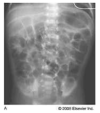Necrotizing enterocolitis in the premature infant: neonatal nursing assessment, disease pathogenesis, and clinical presentation
- PMID: 21730907
- PMCID: PMC3759524
- DOI: 10.1097/ANC.0b013e31821baaf4
Necrotizing enterocolitis in the premature infant: neonatal nursing assessment, disease pathogenesis, and clinical presentation
Abstract
Necrotizing enterocolitis (NEC) remains one of the most catastrophic comorbidities associated with prematurity. In spite of extensive research, the disease remains unsolved. The aims of this article are to present the current state of the science on the pathogenesis of NEC, summarize the clinical presentation and severity staging of the disease, and highlight the nursing assessments required for early identification of NEC and ongoing care for infants diagnosed with this gastrointestinal disease. The distributions of systemic and intestinal clinical signs that are most sensitive to nursing assessment and associated with Bell Staging Criteria are presented. These descriptive data are representative of 117 cases of NEC diagnosed in low-gestational-age infants (<29 weeks' gestation). The data highlight the clinical signs most commonly observed in infants with NEC and thus provide NICU nurses an evidence-based guide for assessment and care of infants with NEC.
Figures


Similar articles
-
Necrotizing Enterocolitis: Enhancing Awareness for the General Practitioner.Pediatr Rev. 2019 Oct;40(10):517-527. doi: 10.1542/pir.2017-0338. Pediatr Rev. 2019. PMID: 31575803 Review.
-
Slow enteral feeding decreases risk of transfusion associated necrotizing enterocolitis.J Neonatal Perinatal Med. 2018;11(3):231-239. doi: 10.3233/NPM-181773. J Neonatal Perinatal Med. 2018. PMID: 29843272
-
Clinical parameters do not adequately predict outcome in necrotizing enterocolitis: a multi-institutional study.J Perinatol. 2008 Oct;28(10):665-74. doi: 10.1038/jp.2008.119. Epub 2008 Sep 11. J Perinatol. 2008. PMID: 18784730
-
Necrotizing enterocolitis risk: state of the science.Adv Neonatal Care. 2012 Apr;12(2):77-87; quiz 88-9. doi: 10.1097/ANC.0b013e31824cee94. Adv Neonatal Care. 2012. PMID: 22469959 Free PMC article. Review.
-
NICU update: state of the science of NEC.J Perinat Neonatal Nurs. 2006 Jan-Mar;20(1):46-50. doi: 10.1097/00005237-200601000-00016. J Perinat Neonatal Nurs. 2006. PMID: 16508462 Review.
Cited by
-
Exploring the distribution of grey and white matter brain volumes in extremely preterm children, using magnetic resonance imaging at term age and at 10 years of age.PLoS One. 2021 Nov 5;16(11):e0259717. doi: 10.1371/journal.pone.0259717. eCollection 2021. PLoS One. 2021. PMID: 34739529 Free PMC article.
-
Acute kidney injury in necrotizing enterocolitis predicts mortality.Pediatr Nephrol. 2018 Mar;33(3):503-510. doi: 10.1007/s00467-017-3809-y. Epub 2017 Oct 5. Pediatr Nephrol. 2018. PMID: 28983789
-
Modeling the interactions of bacteria and Toll-like receptor-mediated inflammation in necrotizing enterocolitis.J Theor Biol. 2013 Mar 21;321:83-99. doi: 10.1016/j.jtbi.2012.12.002. Epub 2012 Dec 10. J Theor Biol. 2013. PMID: 23238281 Free PMC article.
-
Necrotizing enterocolitis in haemolytic disease of the newborn: a retrospective cohort study.Vox Sang. 2020 Feb;115(2):196-201. doi: 10.1111/vox.12862. Epub 2019 Dec 19. Vox Sang. 2020. PMID: 31858620 Free PMC article.
-
Incidence, Risk Factors and Prediction of Secondary Hyperparathyroidism in Preterm Neonates under 32 Weeks' Gestational Age.Nutrients. 2022 Aug 18;14(16):3397. doi: 10.3390/nu14163397. Nutrients. 2022. PMID: 36014908 Free PMC article.
References
-
- Henry MCW, Moss RL. Necrotizing enterocolitis. Ann Rev Med. 2009;60:111–24. - PubMed
-
- Moss RL, Kalish LA, Duggan C, et al. Clinical parameters do not adequately predict outcome in necrotizing enterocolitis: a multi-institutional study. J Perinatol. 2008;28(10):665–674. - PubMed
-
- Llanos AR, Moss ME, Pinzon MC, et al. Epidemiology of neonatal necrotizing enterocolitis: a population based study. Paediatr Perin Epidemiol. 2002;16:342–349. - PubMed
-
- Chandler JC, Hebra A. Necrotizing enterocolitis in infants with very low birth weight. Semin Pediatr Surg. 2000;9:63–72. - PubMed
-
- Petty JK, Ziegler MM. Operative strategies for necrotizing enterocolitis: the prevention and treatment of short-bowel syndrome. Semin Pediatr Surg. 2005;14:191–198. - PubMed
Publication types
MeSH terms
Grants and funding
LinkOut - more resources
Full Text Sources
Other Literature Sources
Medical

